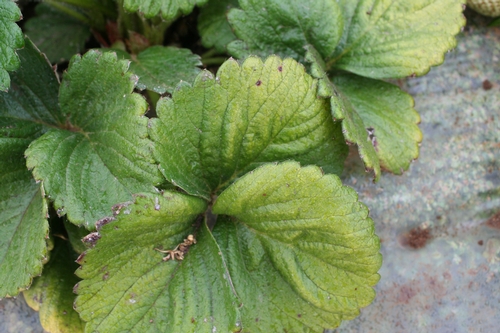
- Author: Mark Bolda
The newest issue of "California Agriculture" just came out and it's all dedicated to research on strawberries.
The main idea of this issue is what the well written intro editorial by Cal Ag Executive Editor Jim Downing describes: what is this industry really going to look like going forward post methyl bromide?
Very high quality line up of peer reviewed writing, including an insightful article written by Laura Tourte and yours truly concerning the evolution of the berry industry on the Central Coast.
Set aside some space to read this, it's going to be time well spent.
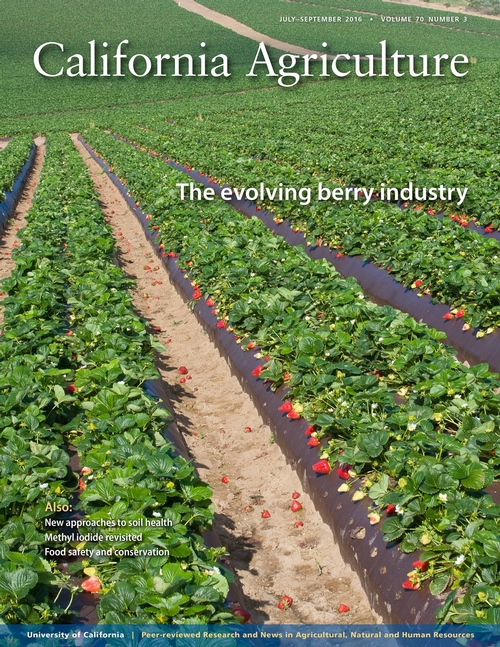
- Author: Mark Bolda
- Author: Steven Koike
- Author: Ed Show
To address the current concern of anthracnose in strawberry for the upcoming 2015-2016 season, Ed Show, Steve Koike and I put together a video featuring a discussion of the issue. It's good to talk about it because it's not a cut and dry case.
For example, out of dozens of suspect samples for anthracnose recently submitted to Steve's UCCE Diagnostic Lab in Salinas, only one has turned up positive for the causal pathogen Colletotrichum acutatum. On the other hand, this winter is supposed to be warm and wet, which could favor the disease if it is around.
The discussion taped here with Steve and I is intended to shed more light on the current situation and help people make a good decision in a timely manner.
Great videography and editing by Ed Show. Really great work.
https://www.youtube.com/watch?v=u2N7Yrm06iY
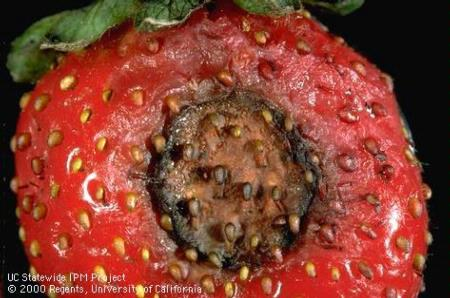
- Author: Steven Koike
- Author: Mark Bolda
September 2015 brought on record high temperatures in agricultural fields in California's central coast. Parts of the Salinas Valley, Pajaro Valley, and Watsonville experienced daytime high temperatures that are rarely seen here. Not surprisingly, various central coast crops exhibited symptoms that were associated with heat damage. Strawberry plantings also showed symptoms of heat damage. One particular manifestation of injury to strawberry resembled anthracnose disease. Strawberry runners had dark brown to black lesions (Photo 1) that initially measured from1/4 to 3/4 inch long. In some cases the lesions could be much longer and could cause the entire runner to wither and dry up (Photo 2).
Field examination and laboratory analysis clearly eliminated the anthracnose fungus (Colletotrichum acutatum) as a cause of this symptom. Strawberry runner lesions never developed any signs (fruiting structures) of any fungal pathogen. In affected fields, thousands of runners were damaged, which is far too many for an anthracnose case in summer and without any rain. 90% of the injured runners were hanging down along the sides of the beds (Photo 3) where direct sun exposure and temperatures would be the greatest; only a few runners on bed tops showed any lesions. Timing was important as a determinant: runner lesions occurred a few days after the maximum daily highs had passed. Finally, extensive testing by the UC Cooperative Extension diagnostic lab resulted in 100% complete negative results for pathogens. Therefore this abiotic damage symptom poses no threats to the plants and is not associated with anthracnose disease.
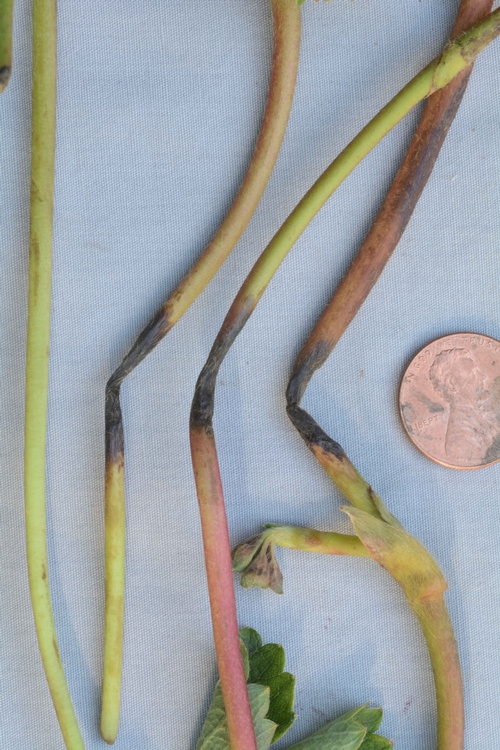
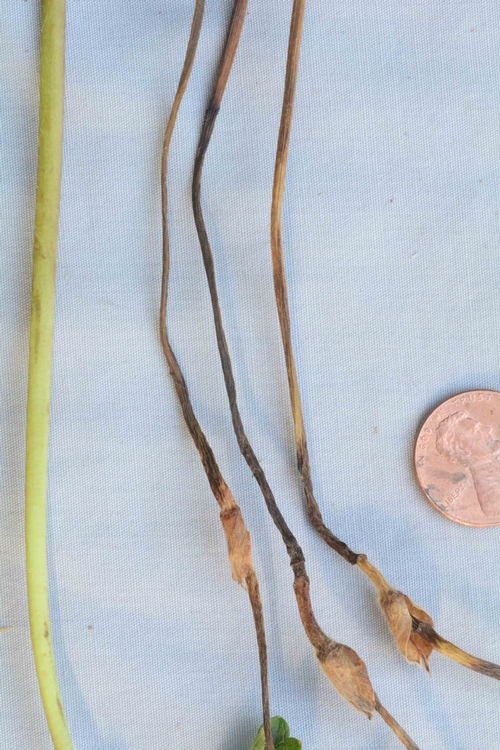
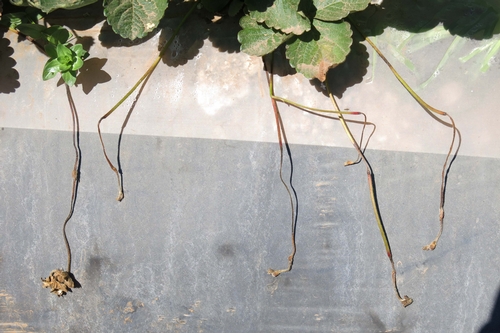
- Author: Mark Bolda
Strawberries (and caneberries) rely on enough accumulation of chill to develop normally. Insufficient chill in strawberry results in lower vigor and productivity, while excessive chill can result in overly vegetative plants with again lowered productivity. This is an expansive topic, and readers can refer to other articles in this blog to familiarize themselves with the concept further.
The question we take up today is with the current spate of warm temperatures during the day in the strawberry plant production areas in Northern California, are we losing some of the accumulated chill during the night. The answer is an unequivocal “yes”.
Consider the chart below taken from the UC Davis Fruits and Nuts website which comes from the publication “Chilling Accumulation: Its Importance and Estimation” by David H. Byrne and Terry Bacon out of the Department of Horticultural Sciences at Texas A&M University:
http://fruitsandnuts.ucdavis.edu/Weather_Services/
chilling_accumulation_models/about_chilling_units/
|
The Byrne and Bacon explanation of calculations used by the Utah model: |
The Pomology Weather Services program calculations for the Utah model: |
|
1 hour below 34°F = 0.0 chill unit 1 hour 35 - 36°F = 0.5 chill units 1 hour 37 - 48°F = 1.0 chill units 1 hour 49 - 54°F = 0.5 chill units 1 hour 55 - 60°F = 0.0 chill units 1 hour 61 - 65°F = -0.5 chill units 1 hour >65°F = -1.0 chill units |
1 hour below 34°F = 0.0 chill unit 1 hour 34.01 - 36°F = 0.5 chill unit 1 hour 36.01 - 48°F = 1.0 chill unit 1 hour 48.01 - 54°F = 0.5 chill unit 1 hour 54.01 - 60°F = 0.0 chill unit 1 hour 60.01 - 65°F = -0.5 chill unit 1 hour >65.01°F = -1.0 chill unit |
Let's go to the accumulator of chill hours from Lassen Canyon Nursery to apply this to our situation today:
http://lassencanyonnursery.com/macdoel-ranch-cumulative-chilling-hours/
As of 9/22/2015, it looks like we have 32 hours (or units) below 32o F (0.0 chill units x 32 accumulated), 143 hours between 33o F and 45o F, 166 hours between 46o F and 60o F, and 177 hours over 61o F (130 from 61o F to 80o F and another 47 over 81o F). I'm assuming the interesting part of chill accumulation for Lassen is the 33o F to 45o F range, which we'll multiply by 1 for 143 chill units, then add on the less effective 46o F and 60o F of 83 chill units (166 hours x 0.5) for a total of 223 accumulated hours in Macdoel so far.
However, from this total of 223 hours accumulated we are going account for the negative effect of 177 hours over 61o F. We don't have the advantage of knowing how many hours were in the range of 60o F to 65o F for which the multiplier is only -0.5 chill units, but indulge me and let's put that amount at a quarter of the 177 hours over 61o F (177*0.25 = 44) . Meaning that (44 hours x -0.5 chill units) + (133 x -1.0 chill units) = -155 chill units.
As such, according to the Utah Model, total accumulation this year as of September 23 in Macdoel is 68 chill units (223 units - 155 units).
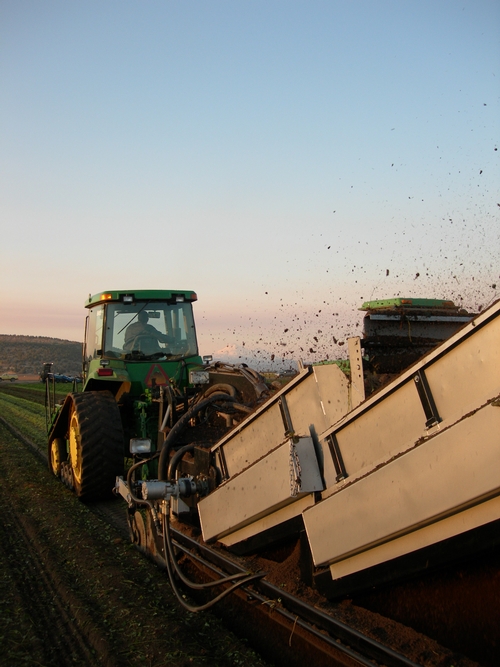
- Author: Mark Bolda
I have an ongoing study with an alternative fumigant (not chloropicrin) compared to an unfumigated control up against the methyl bromide/chloropicrin standard. There's some other stuff in here too, that will be discussed at a later date.
The collaborating grower observed a few weeks ago that plants in the unfumigated control and alternative fumigant were going yellow, in particular the older leaves. That this was not occurring to any sizable degree in the methyl bromide standard was notable.
As many of you my readers know, I really frown upon the identification of leaf yellowing as being caused by this or that deficiency in the absence of any sort of laboratory analysis, so I took two leaf samples from each of the three treatments and submitted them to Perry Labs here in town.
Table 1: Average of two leaf blade samples from unfumigated check, alternative fumigant and methyl bromide standard
| Unfumigated check | Alternative Fumigant | Methyl bromide standard | |
| %N | 2.9 | 2.7 | 3.0 |
| %P | 0.35 | 0.33 | 0.52 |
| %K | 1.2 | 1.15 | 1.34 |
| %Ca | 1.84 | 2.03 | 1.70 |
| %Mg | 0.53 | 0.60 | 0.52 |
| %Na | 0.3 | 0.3 | 0.3 |
| ppm Fe | 134 | 72 | 95 |
| ppm B | 49 | 52 | 54 |
| ppm Zn | 11 | 11 | 11 |
| ppm Cu | 4.4 | 4.1 | 3.6 |
| ppm Mn | 282 | 296 | 304 |
Remembering that two samples per treatment aren't going to give us a what can be called a truly scientific conclusion, these results do at least give us a look at what is going on. First of all, the yellowing probably isn't from nitrogen, which is showing up very much at sufficiency in all treatments. Ditto Ca, Mg and the micros (note that original sample Fe numbers are all over the place); Na is low.
Circling back, we do see that P is lower in both unfumigated and the alternative than the methyl bromide standard, plus the symptoms show up in the older leaves, which checks out for a very mobile element like P. K is just under that recommended from the revised nutrient guidelines from the work I did with Tim Hartz at UC Davis. Additionally, P and K, which come into contact with roots via diffusion in the soil solution (meaning the roots need to grow to the minerals since they are both pretty immobile in the soil) as opposed to mass flow as is the case with nitrate (meaning the nutrient moves to the root since it is mobile), could have their uptake rates reduced by a lessened abundance of roots and root hairs.
The question is then if what we are seeing here is that the lower root growth stemming from less than accustomed fumigation efficacy is also a cause of an apparent deficiency in phosphorous and maybe potassium.
